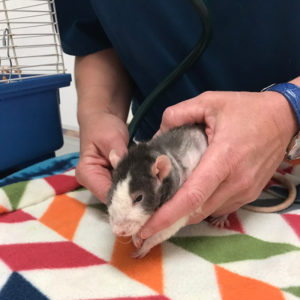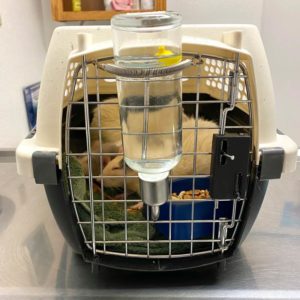Contents

Having pet rats is awesome! Taking them to the veterinarian is less so.
During a recent visit to my vet, I recalled all the times I had sat in that room over the years. It is a bizarrely normal part of my life. So much so, that my vet and I now give each other a quick hello hug when we see each other. I’m lucky to have found such a caring veterinarian who makes these often-difficult appointments less dreadful.
Everything about visiting a vet has the potential for anxiety. This includes finding a vet, paying for the visit, making tough choices, and having a sick pet in the first place. And your rat isn’t likely to be thrilled about it either. Yet, vet visits are an important and necessary part of rat ownership. As I waited in the exam room, I realized it’s a perfect topic to share tips about.
Choosing A Veterinarian For Your Rat

Your first vet visit is likely to come up spontaneously, and probably at a super inconvenient time. I encourage you to find a veterinarian before you actually need one. And you need to choose an exotic vet who specializes in rats.
Looking for the perfect vet can be daunting. Your best options are to read reviews about the clinics in your area or ask other rat owners nearby where they go. And if there’s a reputable rat rescue or breeder close to you, find out who they recommend. After your first appointment, if you don’t feel like the vet was a match, try a different one in the future. Don’t ever think you’re locked in.
Next, look into the kinds of care each clinic provides, such as neuters and spays, tumor removal, and euthanasia. Ask questions about their euthanasia policies, too. Not all clinics allow owners to be with their pets during the procedure, which is an immediate “no” for me. Staying by an animal’s side until the end is a personal preference, but I believe it should be up to the owner and not the clinic.
Find out the cost for a basic rat exam. That is the minimum amount you’re going to pay during an appointment. Additional tests or treatments increase the cost from there.
When To See A Veterinarian

Any vet will tell you that every pet would benefit from a yearly wellness checkup. Not everyone can afford to do this, however, especially with rats. Their pint size does not equal pint-sized pricing. Continually educating yourself about rat health and learning how to spot early signs of aliments or illness is your next best option.
Rats are notoriously good at hiding symptoms, making it difficult at times to judge if a vet is needed. Signs of respiratory infection, pain, diminished appetite, strange new behavior, aggression, lethargy, body lumps, or injury definitely are reasons to seek a vet. But if it’s less obvious, call your vet clinic to see if they recommend making an appointment.
Affording A Veterinarian

Healthcare for rats is not cheap. For many of us, an unexpected health issue can create some financial panic. I think it even keeps many people from ever taking their rats to the vet in the first place. And newer owners are often unaware of the expenses that can arise. It’s never too late to prepare for them though.
The first thing I suggest is starting a saving account specifically for vet care or miscellaneous rat needs. When my son was growing up, we even made him put a portion of his monthly allowance aside for his cat.
Look into billing options at your vet’s clinic. See if they take payment installments or have financing options. Or look into the cost and benefits of pet insurance — some do cover rats. There are also credit cards explicitly for health financing. These can come with high interest rates, so do your homework first.
Transportation Supplies For Your Rat

Once it’s time for the vet appointment, you need a proper carrier to safely transport your rat. A cat carrier or a small wire cage works well. When choosing a cat carrier, look for one that allows you to attach a water bottle. If transporting several rats or traveling a long distance, then I suggest the wire cage. This allows you room for an igloo or a space pod that your rats can hide in. And the cage is chew-proof. Cat carriers tend to have plastic sides with holes for ventilation, which your rats can easily chew through if left in one long enough. A cage made of wire bars prevents that. Regardless of the carrier, put in a T-shirt, pieces of fleece, or lay down a hammock to make them more comfortable.
You also need a small food dish and a water bottle that can attach to the side of the cage or carrier. But keep an eye on the water, because the bottles tend to leak when being jostled around.
Your rat is likely to be apprehensive during this little “adventure,” so allow your pal to get used to the carrier/cage during a more relaxed time. Nervous rats also poop soft, wet poops — a lot. From past experience, I now always bring along a couple of empty groceries bags (to hold trash), a roll of paper towels, and a pack of unscented baby wipes for any potential cleanups. Take the wet wipes into the exam room too!
The back seat is a safer place for the carrier than the front seat. Be sure that the car stays adequately cooled or heated during the entirety of the drive. Use a sheet or sun shade to shield the cage from excess sun if needed.
The Veterinary Exam

Whenever possible, read up on symptoms and their causes before the exam. This helps you formulate questions beforehand and gives you a better understanding of treatment options and medications. The Rat Guide is an excellent source for this. Research done or not, be prepared to know the general age of your rat and have a list of symptoms and/or concerns ready.
Some rats are curious and carefree during the exam, but the majority of them are either apprehensive or frightened. My first rat continually leapt out of the vet’s hands and onto my shoulder to hide under my hair. Now I bring a bonding pouch or a cloth hut to the clinic for my more anxious rats. This way they feel safer while on the exam table. This is especially useful with my older rats that have mobility issues and/or are in pain, which can be made worse if forced to stand on a hard, cold, metal tabletop.
Absolutely spend the visit comforting and reassuring your rat during the exam and offer them praise through pets or treats if they will take them.
Once you’re home, give your rat a snack and let them have some time to themselves to recoup from what they probably thought was a harrowing experience.
Saving On Medication

Medications often make up the bulk of a vet bill. Many clinics charge a “filling fee” for medications, which can really hike up the price. And it’s rarely for a full bottle. To be fair, the upcharge is because clinics have to properly store these medications, which they prepurchase in bulk amounts.
The good news, though, is that you can request to have medications filled elsewhere. Medications also used by humans can be filled at a regular pharmacy. I get amoxicillin, for instance, from a local pharmacy. Apps like GoodRx can sometimes provide additional discounts.
Compounding pharmacies fill both human and many animal prescriptions, and they offer a variety of flavors to make the medications more palatable. Some of their antibiotics can last up to six months as well, when properly stored. Rats often require antibiotics anywhere from two to six weeks. If they have a respiratory infection, it’s not uncommon for a cagemate to need medication as well. Having extra medication is a huge help!
You can also request to have meds filled through online pharmacies. I order the pain medication, meloxicam (i.e., Metacam) from Chewy. It’s a lot more money initially, but the bottle is good for a couple of years, which makes it much cheaper in the long run. If medications are being shipped, find out how long delivery takes. You don’t want your rat waiting too long. And always purchase from a reputable pharmacy.
It takes more effort on your part to look into costs and figure out which pharmacy is best for each medication, but it’s worth the time. Our dog’s monthly medication would cost us $50 a month, or $600 year, if filled at her vet clinic. But I found it at our grocery store pharmacy for only $4 a month, or $48 a year.
While none of this advice magically makes a trip to the veterinarian a joy, I hope it at least alleviates some of the stress.




